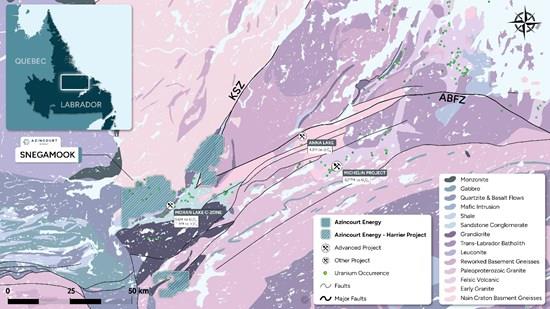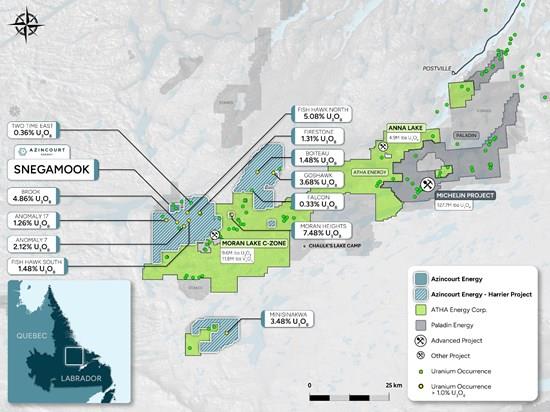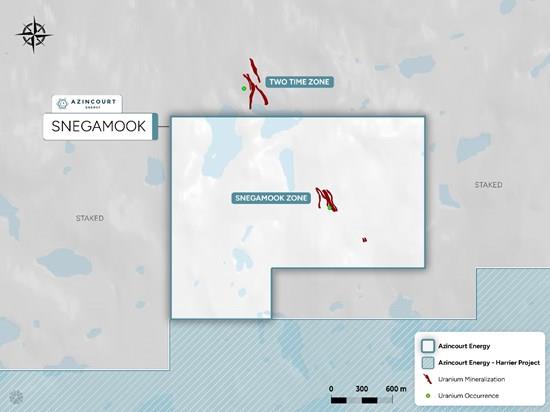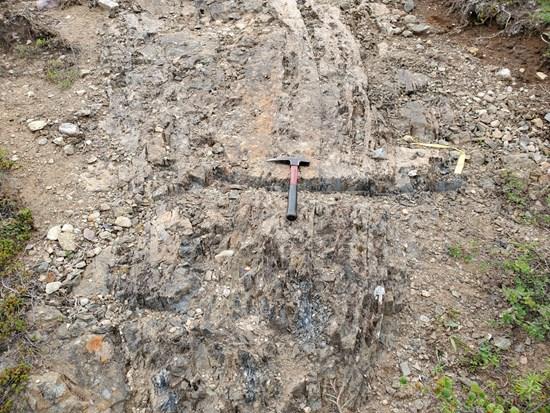Azincourt Energy Completes Initial Work Program On The Harrier Uranium Project
- District-Scale Land Package: 49,400 ha in Labrador's Central Mineral Belt, adjacent to Paladin Energy's Michelin deposit and Atha Energy's Moran Lake Project. Known Uranium Mineralization: 12+ known uranium zones with rock samples up to 7.48% U3O8 , and 10 distinct zones >1% U3O8 . Historic work has been limited (124 drill holes total). 2025 Program Complete : Confirmed known showings , advanced Snegamook, and identified 2 new uranium showings (assays pending). Snegamook Priority : Historic drilling intersected 20-50m wide uranium zones ; Azincourt plans to update Snegamook to NI 43-101 resource with an upcoming drill program. Pipeline of Drill-Ready Targets : Moran Heights, Boiteau Lake, Anomaly 7 and others advancing toward 2026 drill programs.
Vancouver, British Columbia--(Newsfile Corp. - October 1, 2025) - AZINCOURT ENERGY CORP. (TSXV: AAZ) (OTCQB: AZURF) (" Azincourt " or the " Company ") is pleased to announce that the introductory work program has been completed on the Harrier Project in the Central Mineral Belt in Labrador, Canada.
About the Harrier Project
Azincourt's Harrier Project - which includes its previously acquired Snegamook deposit - covers 49,400 hectares over five distinct licence groups, representing one of the largest land positions in the Central Mineral Belt of Labrador. The Harrier Project straddles key uranium-bearing structural corridors directly adjacent to and on trend with Atha Energy's Moran Lake and Anna Lake projects, and Paladin Energy's Michelin project - placing Azincourt at the center of a proven and growing uranium camp.
The Harrier Project, with over a dozen known uranium mineralization zones and surface rock samples grading up to 7.48% U3O8 (and >1.0% U3O8 in 10 distinct zones), offers a rare combination of grade, scale, and geological continuity. Notably, only 124 drill holes (19,851 metres total, over half of this on the former Snegamook project area) have ever been completed across the combined property -leaving ample opportunity for new discovery with modern methods.
2025 Summer Work Program
The introductory work program was completed in late August and consisted of helicopter supported reconnaissance of existing identified uranium occurrences and prospecting of previously identified radiometric anomalies. A crew consisting of one pilot, two geologists, including Trevor Perkins, Azincourt's Vice President of Exploration, and three prospectors conducted the field program. The purpose of this program was to expand the target inventory on the project and prepare the higher priority targets for a diamond drilling program.
Eleven previously identified uranium showings and the Snegamook Deposit were visited by Azincourt's VP Exploration to get an understanding of the characteristic and settings of the uranium mineralization present on the property. At this time, the focus was on those showings that had uranium mineralization present in outcrop, as less work is required to get these targets "drill ready". Two new uranium showings have been identified in outcrop in the Boiteau Lake area and in boulders and outcrop east of the Anomaly 7 area. Assay sample results are pending for these areas.
Snegamook Deposit
A high priority target for diamond drilling is the Snegamook Uranium Deposit, where drilling in 2007 and 2008 to follow up a radon gas anomaly identified uranium mineralization located 1.3 km along strike to the southeast of the Two Time Zone (Indicated and Inferred resource of 5.55 Mlb U3O8, Silver Spruce Resources, June 2008). 17 drill holes intersected a 20 to 50 m wide section of uranium bearing brecciated and altered monzodiorite with moderate to strong chlorite, hematite and carbonate alteration, the same geological setting as the Two Time Zone. (Figure 3)
The location of the drill core from the 2007-2008 exploration programs was confirmed at the old camp site used by Silver Spruce Resources. Much of the core is in decent shape considering it has been exposed to the elements for almost 20 years. Several drill holes that intersected the Snegamook Deposit mineralization were examined and a few samples were collected to confirm uranium grades. Reconnaissance of the deposit area was also undertaken to examine ground conditions for future drilling and examine the old drill pads for confirmation of hole numbers, locations, and hole orientation. Many drill pads were easily recognizable and marked with casings and tagged wooden posts present.
In 2008 a preliminary resource estimate for the Snegamook Zone was prepared by Silver Spruce Resources, however it was never finalized in a report or filed. Diamond drilling and preparing an updated NI 43-101 compliant resource for this deposit will be a priority for Azincourt, in conjunction with the 2026 field program.
Moran Heights
The Moran Heights Prospect is underlain by a sequence of sandstone, conglomerate and minor intercalated volcanic flows. These rocks are overlain by a thick sequence of subaerial bimodal volcanic rocks ranging from andesite and basaltic andesite to ignimbrites and rhyolite. The prospect is along trend of, and in a similar geologic setting as the Moran Lake C uranium deposit.
The showing itself is identified from outcrop and an exploration pit along the southeast side of a high northeast trending ridge. Extensive work was conducted sporadically between 1979 and 2006 consisting of trenching and diamond drilling. One sample collected from the pit in 2024 assayed 7.48% U3O8. The historical diamond drilling, oriented to the northwest into the ridge from the base, intersected grades up to 0.2% U3O8. It appears that the historical drilling may have undercut the higher-grade mineralization. A 3D interpretation of this showing will be completed prior to follow-up drilling.
Boiteau Lake Group
The Boiteau Lake Group is the northernmost block of the Harrier Project and straddles the Kanariktok Bay Shear Zone (KSZ, Figure 1). The licences are underlain by a sequence of sandstone, conglomerate, and massive volcanic flows. The Boiteau Lake is located in a different structural setting than the rest of the Harrier Project.
Airborne magnetics, Landsat imagery, air photo interpretation and ground investigation identified a 12 km long, northeast trending structural corridor located in the heart of the Boiteau claims. Significant uranium mineralization was found in 2008 in nine separate bedrock showings over a strike length of nearly 4.5 km. Samples returned very high grades, including 1.48% U3O8 and 1.10% U3O8. The source of these boulders has yet to be determined. The main structure controlling the area trends southwest, parallel to the KSZ and dips steeply to the northwest.
At the south end of the Boiteau trend, the Boiteau Main showing has pitchblende and secondary uranium disseminated in metasedimentary rocks associated with steep west trending fractures dipping to the north. Samples from this area collected in 2024 returned up to 0.32% U3O8.
The Boiteau Central showing consists of a sequence of steeply dipping splayed fractures containing pitchblende (Figure 4) in slatey grey metasediments in the footwall of a significant southwest trending fault and trending perpendicular to that fault. Samples from 2024 in these fractures returned grades of up to 0.24% U3O8.
The Boiteau North showing consists of pitchblende veins in a grey metasediment dipping moderately to the west-northwest on the southeast side in the footwall of a southwest trending fault. Samples collected by Koba in 2024 returned 0.38% U3O8.
A new uranium showing has been identified during Azincourt's 2025 summer program, approximately 200 m to the northeast of the Boiteau Main showing. This outcrop extends at least 30 m with anomalous radioactivity identified reading up to 7,200 cps on a Radiation Solutions RS-120 "Super-Scint" scintillometer. This outcrop is to the west of the ridge marking the footwall of the structure and location of the Boiteau Main showing and may indicate the presence of mineralization in the hanging wall of the fault. Assay results are pending for samples collected from this outcrop.
Anomaly 7
The Anomaly 7 Prospect was first discovered in the 1970s. Mineralization has been mapped over 3.5km of strike. In 2024, an outcrop sample returned values of 1.71% U3O8. In addition, historical rock samples have returned assays up to 2.12% U3O8.
Mineralization appears as pitchblende and secondary uranophane hosted in north-northwest trending steeply dipping veins where these veins intersect a series of parallel east-northeast trending hematite altered breccias. Old drill pads were found along the edge of the anomaly, but there is an indication that some of these holes never went deep enough to intersect the mineralization.
Other Showings
The Anomaly 17, Brook, Fish Hawk North, and Fish Hawk South showings were examined and have similar structural settings as Anomaly 7, with intersecting fractures hosting pitchblende mineralization. Historical core was discovered in the woods from the Fish Hawk South showing, however the condition of the core precludes its usefulness for helping to interpret the area.
The Minisinakwa showing has good grades returned from boulders along an east-west trending splay fault. Mineralization is hosted in a magnetite rich metasediment. Drilling underneath boulder trend identified the magnetite rich lithologies, but not the mineralization.
"I was excited to get into the field with the crew and have a good look at the Harrier Project," commented Trevor Perkins, Vice President of Exploration. "The structural setting seems relatively straightforward. We have targets at some of these showings that I would consider drill-ready," continued Mr. Perkins. "At the same time, this is a huge land package with many additional anomalies yet to be examined. Our next step is planning a diamond drilling program for 2026."

Figure 1: Azincourt land position overlain on the geology of the Central Mineral Belt, Labrador, Canada
To view an enhanced version of this graphic, please visit:

Figure 2: Azincourt's Harrier Project
To view an enhanced version of this graphic, please visit:

Figure 3: Snegamook and Two Time Zone mineralization map
To view an enhanced version of this graphic, please visit:

Figure 4: Picture of mineralized fractures in the Boiteau Lake Central area
To view an enhanced version of this graphic, please visit:
About the Central Mineral Belt
Labrador's Central Mineral Belt ("CMB") is one of Canada's most underexplored yet highly prospective uranium regions. Known for its numerous uranium and base metal deposits and showings, the CMB has seen renewed interest due to growing global demand for secure, domestic uranium supply as countries aim to increase nuclear power capacity to meet net-zero emissions goals.
The CMB hosts multiple large-scale uranium discoveries, including Paladin Energy's Michelin Uranium Project (127.7 million lbs U3O8), the Moran Lake C Deposit (historical resource of 9.6 Mlbs U3O8 and 11.8 Mlbs V2O5), and the Anna Lake Deposit (historical resource of 4.9 Mlbs U3O8). These known resources demonstrate the Belt's exceptional uranium endowment - but vast areas remain underexplored, with modern techniques only recently being applied across the region.
With its stable jurisdiction, historical high-grade discoveries, and modern exploration momentum, the CMB is emerging as one of North America's most exciting uranium exploration corridors.
Qualified Person
The technical information in this news release has been prepared in accordance with the Canadian regulatory requirements set out in National Instrument 43-101 and reviewed and approved on behalf of the Company by C. Trevor Perkins, P.Geo., Vice President, Exploration of Azincourt Energy, and a Qualified Person as defined by National Instrument 43-101.
About Azincourt Energy Corp.
Azincourt is a Canadian-based resource company specializing in the strategic acquisition, exploration, and development of alternative energy/fuel projects, including uranium, lithium, and other critical clean energy elements. The Company is currently active at its East Preston uranium project located in the Athabasca Basin, Saskatchewan, and its Snegamook and Harrier uranium projects, located in the Central Mining Belt of Labrador.
*The historical results, interpretation and drill intersections described here in have not been verified and are extracted from news releases issued by Silver Spruce Resources Inc on April 24, 2008, and August 12, 2008, as well as annual Management Discussion and Analysis documents filed on , and Koba Resources Limited on April 11, 2024, and August 20, 2024, which can be found at . The Company has not completed sufficient work to confirm and validate any of the historical data contained in this news release. The Company considers the historical work a reliable indication of the potential of the Harrier Project and the information may be of assistance to readers.
The information on the Michelin, Moran Lake C, and Anna Deposits has been extracted from the websites and investor presentations of Paladin Energy Limited and Atha Energy Corp.
ON BEHALF OF THE BOARD OF AZINCOURT ENERGY CORP.
"Alex Klenman"
Alex Klenman, President & CEO

Legal Disclaimer:
MENAFN provides the
information “as is” without warranty of any kind. We do not accept
any responsibility or liability for the accuracy, content, images,
videos, licenses, completeness, legality, or reliability of the information
contained in this article. If you have any complaints or copyright
issues related to this article, kindly contact the provider above.
Most popular stories
Market Research

- Alt.Town Introduces $TOWN Token Utility Across Platform Services And Launches Valuefi Deposit Event
- BTCC Exchange Maintains 143% Total Reserve Ratio In September 2025 Demonstrating Continued Financial Strength
- Salvium Solves The Privacy Paradox: Salvium One Delivers Mica-Compliant Privacy That Exchanges Can List
- Zebu Live 2025 Welcomes Coinbase, Solana, And Other Leaders Together For UK's Biggest Web3 Summit
- Tapbit At TOKEN2049: Reshaping The Crypto Landscape Through Product Innovation
- Thrivestate Launches“Fly Before You Buy” Program, Enabling International Buyers To Explore Dubai Before Committing





















Comments
No comment